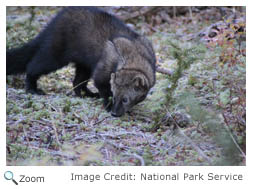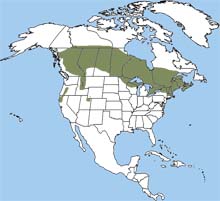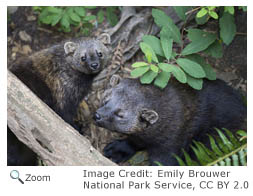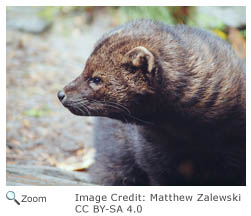Characteristics
 The fisher has a long body and dark brown to light brown fur. It has long claws on both its hind and front paws. Its front and hind legs are black and it has a long, thick, black tail. It has a short muzzle and round ears on the sides of its head. The fisher has a long body and dark brown to light brown fur. It has long claws on both its hind and front paws. Its front and hind legs are black and it has a long, thick, black tail. It has a short muzzle and round ears on the sides of its head.
Range
 The fisher can be found in central and southern Canada, northern California, in the Rocky Mountains and in New York and New England. The fisher can be found in central and southern Canada, northern California, in the Rocky Mountains and in New York and New England.
Habitat
The fisher lives in thick coniferous or mixed coniferous and hardwood forests. It prefers habitats with lots of tree cover and lots of hollow trees for dens.
Diet
 The fisher is mainly carnivorous. It usually hunts animals that are the same size or smaller than it is. Common prey of the fisher includes chipmunks, shrews, snowshoe hares and porcupines. The fisher is mainly carnivorous. It usually hunts animals that are the same size or smaller than it is. Common prey of the fisher includes chipmunks, shrews, snowshoe hares and porcupines.
When it preys on porcupines,
it attacks the porcupine's face repeatedly until the porcupine is weakened from trying to defend itself. It will eat the porcupine's organs first and save the rest of the kill to eat over the next couple of days. Fishers don't always win battles with porcupines and they are sometimes badly injured or killed by the porcupine's quills. The fisher also eats fruits, berries, plants and carrion. The fisher, despite its name, rarely eats fish.
|
|
Life Cycle
 Fishers mate in March and April. The female gives birth ten to eleven months after mating. She has one to six babies in a nest in a hollow tree. The babies are blind at birth. If the nest is disturbed, the female will move her babies. Fishers mate in March and April. The female gives birth ten to eleven months after mating. She has one to six babies in a nest in a hollow tree. The babies are blind at birth. If the nest is disturbed, the female will move her babies.
Behavior
 The fisher is usually nocturnal. A fisher's home range is usually about ten square miles and may overlap with the home ranges of a number of other fishers. It uses scent to mark its territory. A fisher moves around its home range frequently, following well-used trails. It travels both on the ground and through the trees. The fisher makes its den in crevices, under bushes, in logs and in trees. In the winter it sometimes will use a den in the snow. The fisher is a very good swimmer and excellent climber. The fisher is usually nocturnal. A fisher's home range is usually about ten square miles and may overlap with the home ranges of a number of other fishers. It uses scent to mark its territory. A fisher moves around its home range frequently, following well-used trails. It travels both on the ground and through the trees. The fisher makes its den in crevices, under bushes, in logs and in trees. In the winter it sometimes will use a den in the snow. The fisher is a very good swimmer and excellent climber.
|